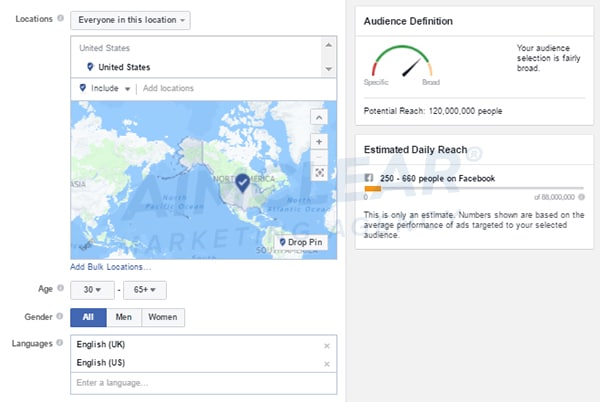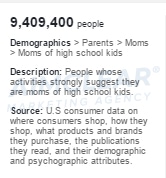The National Center for Education Statistics projected that about 20.5 million students were expected to attend American colleges and universities in fall 2016. With between one and four potential parents, stepparents and/or guardians in their lives, we’re looking at 20.5 million to 82 million parents of college students in this country. That’s a tempting and sought-after audience for many conversion-hungry marketers. A myriad of products are ripe for the picking. From practical school-focused tools like textbooks and supplies to countless options of care-package-appropriate items, it’s almost TOO easy playing marketing matchmaker between audience and offering.
Parents of college students has been a non-existent segment in terms of social advertising preset audiences, and impossible to definitively define via psychographic targeting. But as targeting options expand within social networks like Facebook, so too does the possibility of creatively concocting a solution. Fortune favors the bold (and persistent), so let’s try!
Set a baseline
First, create a general baseline that, at the most basic level, defines parents of college students. In terms of gender, location and language, focus on those living in the United States who speak English (unless you’re running campaigns in another language) and are male or female. Age gets tricky. With parents having children at a wide range of ages, and those children staying in school a varying number of years (with most students at public universities now taking six years to graduate), there is no clear-cut age window. For the sake of getting started, let’s set our parental age at 35-65+. What baseline does this provide? 120 million people.
Now let’s add the most basic parent-related narrowing layer currently provided: “(18-26 Years) Parents with Adult Children.” This presents our first (of many) internally questioning, but-what-about type of roadblocks. Some college students are older than 26, like frequent degree switchers, extra-ambitious grad schoolers, medical mavens and the random lifetime learner. While it leaves a lot to be desired and many parents off the table, there isn’t a clear alternative.
In the name of further rabbit-hole folly, let’s proceed. After narrowing our 120 million baseline to parents of adult children, we’re left with an audience of 22 million. With 20.5 million students in the US, at an average of, say, 1.5 parents per individual, we should be looking at over 30 million parents. Then factor in that an estimated 62 percent of the entire adult population is on Facebook, and we’re left with a more manageable 19-million-person dream audience. That’s pretty close! Onward!
Just because Facebook has identified these individuals as parents of college-aged individuals, it does not mean they ARE college-attending individuals. Additional narrowing is required.
Necessary narrowing
A quick search of targeting terms like “college” and “higher education” reveals a very interesting potential layer in “Behaviors > Purchase behavior > Subscription services > Higher education.”
While this grouping reflects “people who are receptive to offers for online higher education programs,” one CAN dream on the possibility of it including those receptive to offers, but not necessarily offers FOR THEM (in other words, their children). The result: 3.5 million people.
Eh. Not great. Again, with a hypothetical target of 19 million parents of college students, the numbers aren’t aligning. For the sake of intrigue, what else could we layer to get rid of those who may be interested in higher education for themselves? Let’s exclude those in college, those whose highest education is high school or some college/grad school (who would theoretically be looking for and receptive to offers for themselves)! The result: 2.2 million people.
Once again, not great. At this point, you may be thinking, “why don’t you just target interest in the university?!”. If so, you’re in good company, as this possibility WAS brought up by several AIMCLEARians when discussing the scenario. The trouble with that option is that while it IS a college-related interest, it doesn’t relate to the individuals’ children or what school they attend. And yes, same goes for Ivy-Leaguers. While it makes sense that their children would follow in their footsteps, if it can’t be proven, we wouldn’t recommend it.
Exclude to improve
By focusing on what a desired audience DOESN’T look like, you may find loopholes that tactical targeters dream about. Parents of college students tend to not have a TON of liquid cash, right? While an assumption, and less desirable than hard fact, it presents an interesting opportunity, as Facebook allows us to include/exclude individuals with total liquid investable assets of varying amounts.
For the sake of exploration, let’s exclude anyone with more than $100,000 of liquid assets, on top of the existing parents with adult children baseline. The result: 15 million people.
Better, but at the end of the day, this COULD be people with adult children who simply don’t have liquid assets exceeding $100K, and nothing more than that. Their children could have graduated high school (or not!) and immediately made their way into the wonderful working world!
By including an additional exclusion layer of household compositions of “Young adults in home,” we address that issue. The result: 12 million. While those 3 million parents left off the table could theoretically include people with a child in college and another child still at home, or perhaps the child in college is still living at home, it (hopefully) excludes those who have children not attending college, living at home.
Having come this far down the psychographic targeting path, logical next layers are less obvious than before. With this in mind, let’s step back and reassess what we are looking at.
Are the 12 million individuals before us really parents of college students? Perhaps. But…
(A) there are certainly many college students older than 26,
(B) some college parents have more than $100K in liquid assets, and
(C) others (who have been left off the table) may have a child in college AND a young adult in their home.
It’s not conclusive, and we can’t claim it to be.
Mentally exhausting, right? Welcome to our world.
One COULD roll with this audience, pitch it as college parents and see where a campaign leads, but it’s not recommended. That would be both illogical and unwise. It would represent a partial guess paired with a potentially major mishandling of client trust (and budget).
With a constant focus on doing what’s right, not what’s easy, we at AIMCLEAR chalk these unsuccessful targeting experiences up to education, and leave it at that. We take newly gained knowledge into forthcoming endeavors and, where appropriate, politely push the powers that be for further focus.
Moving forward (Facebook, don’t fail me now)
Psychographic experiments demonstrate that while Facebook continues to evolve as an advanced targeting trailblazer, some major audiences have been left behind. It’s rather odd, considering you can already target moms of preschool, grade school or high school kids.
Really, Facebook and third-party consumer data providers? Couldn’t just throw in moms (and dads) of college kids as an option?
We see how it is.
Also, we can’t help but mention that Facebook, a college-based development, has been allowing users to recognize familial relationships since May 2009. While it’s anyone’s guess as to how many users actually make family-focused connections on Facebook, familial-based data must exist. Whether Facebook deems this worthy of making public/marketable is another question altogether.
What SHOULD be Facebook’s next-level targeting game-changer, and feverishly demanded by the masses? Second-person persona targeting: Identify a persona and then target anyone who is related through a specified relationship.
It could work as simple as this:
- Step 1: Identify a persona with available data, say, in college, between the ages of 18 and 30, at the University of Wisconsin – Madison, studying history.
- Step 2: Choose a relationship to that type of person, the person you really want to target, like mother of, father of, cousin of, friend of (college), friend of (high school), etc.
- Step 3: Smile. You’re now looking at first-person verified (via the relationships declared by both parties) parents, cousins or friends of college students.
Please say “yes” to this address, Facebook. Please?
If you’ve had success targeting parents of college students, had a similar targeting journey or simply want to join the movement in pushing for more extensive targeting options, drop a line in the comment section below! Happy targeting!























